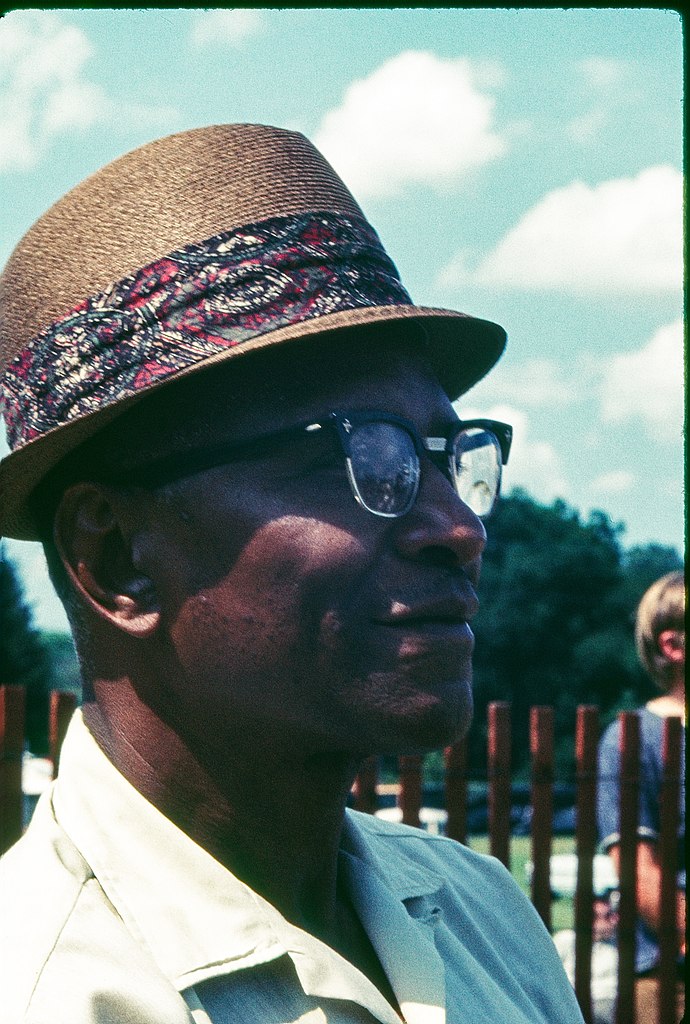The African American originated folk music form known as “the blues” became popular in Indianapolis after World War I with increased migration of southern Blacks to the city. In the early 1920s popular local blues pianists included Jimmy Collins, Tom and Phil Harding, “Funky Five,” Jesse Crump, and Arthur “Montana” Taylor. Jesse Crump, born in 1906 in Dallas, Texas arrived in Indianapolis in 1923 and performed at the Golden West Cafe on ; he recorded as a soloist (“Mr. Crump’s Rag,” “Golden West Blues”) and as an accompanist with vocalists Nina Reeves and Genevieve Steams, later moving to Chicago to record and tour with singer Ida Cox.

Montana Taylor, born in 1903 in Montana, played in Indianapolis at the Hole in the Wall, Goosie Lee’s Rock House, and the Golden West Cafe. He recorded “Indiana Avenue Stomp” and several other sides for Vocalion in 1928 at an Indianapolis field recording session that was also the recording debut for pianist-singer (1905-1935) and guitarist (1903-1962), the most successful and innovative blues duo of the period. Carr and Blackwell made over 100 records together and toured throughout the Midwest until Carr’s sudden death from nephritis. Other local recording activity in the 1920s included Lulu Jackson singing and playing guitar for Vocalion in 1928 and pianist Herve Duerson performing several solo piano sides for Gennett in 1929 (“Naptown Special,” “Avenue Strut”).
Blues musicians residing in Indianapolis during the 1930s included pianist William “Champion Jack” Dupree, guitarist Amos Easton (aka Bumble Bee Slim), guitarist Bill Gaither (aka Leroy’s Buddy), and pianist Pleasant Joseph (aka Cousin Joe). Dupree, born in 1910 in New Orleans, Louisiana began his five-decade recording career with several Okeh sides cut in 1940 while performing with singers Ophelia and Toots Hoy at the Cotton Club, Astoria, and Lincoln Theatre. Joseph, born in 1907 in Wallace, Louisiana entertained with Dupree and the Hoys in 1940 before moving to New York and recording for Savoy, Decca, and Bluebird. Easton, born in 1905 in Brunswick, Georgia performed in Indianapolis from 1928-1930 before moving to Chicago to become one of the most popular blues singers of the 1930s. Decca Record groomed Louisville native Gaither as a successor to Carr and made 118 Decca and Okeh sides, often accompanied by Indianapolis pianist Honey Hill. Guitarist John Brim, born in 1922 in Hopkinsville, Kentucky spent 1941-1945 in Indianapolis before moving to Chicago and then to Gary, Indiana, where he recorded extensively for Chess and JOB. Guitarist Edward Lamonte “Pete” Franklin (1927-1975) was an Indianapolis native who traveled the United States in the 1940s and 1950s, recording for RCA Victor in 1947 and for Flyright and Blue Goose in the 1960s.

Guitarist (1908-1974) moved to Indianapolis in 1928 from Mississippi and recorded albums for Bluesville, Blue Goose, and Flyright labels during the 1960s and 1970s. was a mandolinist who recorded with several renowned country blues artists of the 1930s before arriving in Indianapolis in 1957. Other notable local blues figures included bassist Wilson Swain and harmonica player James Easley, guitarists William “Dollar Bill” Cox, John Tyler Adams, Raymond HoUoway Jessie Ellery Harvey Cook, and William “Lefty” Bates.
After World War II, blues in Indianapolis was overshadowed by the city’s burgeoning scene and was less frequently heard in commercial venues until the 1970s when older blues performers such as Rachell, Griffith, and Bates began playing to younger audiences outside the traditional blues community, sparking an Indianapolis blues resurgence abetted by promotional groups like the Blues Society of Indiana, radio deejays, and a new crop of blues-oriented music bars throughout the city.
*Note: This entry is from the original print edition of the Encyclopedia of Indianapolis (1994). We are currently seeking an individual with knowledge of this topic to update this entry.

Help improve this entry
Contribute information, offer corrections, suggest images.
You can also recommend new entries related to this topic.